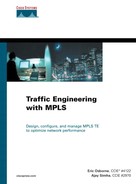What Is Traffic Engineering?
Before you can understand how to use MPLS to do traffic engineering, you need to understand what traffic engineering is.
When dealing with network growth and expansion, there are two kinds of engineering—network engineering and traffic engineering.
Network engineering is manipulating your network to suit your traffic. You make the best predictions you can about how traffic will flow across your network, and you then order the appropriate circuits and networking devices (routers, switches, and so on). Network engineering is typically done over a fairly long scale (weeks/months/years) because the lead time to install new circuits or equipment can be lengthy.
Traffic engineering is manipulating your traffic to fit your network. No matter how hard you try, your network traffic will never match your predictions 100 percent. Sometimes (as was the case in the mid- to late-1990s), the traffic growth rate exceeds all predictions, and you can't upgrade your network fast enough. Sometimes, a flash event (a sporting event, a political scandal, an immensely popular web site) pulls traffic in ways you couldn't have planned for. Sometimes, there's an unusually painful outage—one of your three cross-country OC-192s fails, leaving traffic to find its way from Los Angeles to New York via the other two OC-192s, and congesting one of them while leaving the other one generally unused.
Generally, although rapid traffic growth, flash events, and network outages can cause major demands for bandwidth in one place, at the same time you often have links in your network that are underutilized. Traffic engineering, at its core, is the art of moving traffic around so that traffic from a congested link is moved onto the unused capacity on another link.
Traffic engineering is by no means an MPLS-specific thing; it's a general practice. Traffic engineering can be implemented by something as simple as tweaking IP metrics on interfaces, or something as complex as running an ATM PVC full-mesh and reoptimizing PVC paths based on traffic demands across it. Traffic engineering with MPLS is an attempt to take the best of connection-oriented traffic engineering techniques (such as ATM PVC placement) and merge them with IP routing. The theory here is that doing traffic engineering with MPLS can be as effective as with ATM, but without a lot of the drawbacks of IP over ATM.
This book is about traffic engineering with MPLS; amazingly enough, that's also this book's title! Its main focus is the operational aspects of MPLS TE—how the various pieces of MPLS TE work and how to configure and troubleshoot them. Additionally, this book covers MPLS TE design and scalability, as well as deployment tips for how to effectively roll out and use MPLS TE on your network.
